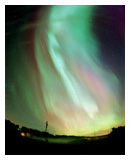|
|
Another astrophotographer follows ... - by David LeeWebsite archive 1995-2013 |
Victoria Centre is part of the national Royal Astronomical Society of Canada, which is dedicated to bringing information about astronomy to the general public. |
|
|
|
|
 Friday night I had good intentions to observe the Perseid meteor shower. This was despite the fact that the moonlit night would make meteor sighting more difficult. As every amateur astronomer knows it's good to catch a nap prior to an early morning session with the stars. Common sense would dictate the use of an alarm clock. I'm sure I set that clock! Waking up at 2:30am I thought it was too late to go out. I went out the front door where I saw the moon setting. The amber coloured globe was nestled between two houses in the south west. Turning around to the north I saw the distinctive shimmering of the sky. Aurora, who cares about the Perseids! I grabbed my camera and fumbled around looking for film. All I could find was a roll of Fuji Superia ISO 200 ... it would have to do. As it turned out faster film wasn't necessary. Island View Beach has been a favourite haunt for many of us, so it was an obvious destination. When I arrived I could see a light mist, but the sky was ablaze with aurora. Only a few cars were in the parking lot. I noticed the aurora covered the area of the sky from Cygnus to Cassiopeia reaching from zenith to horizon line. The characteristic green glow had hints of red, barely detectable to the eye. The constellations were visible through the filmy green glow.
I fired off a couple of frames and turned on my red flashlight to check camera settings. I could hear footsteps in the distance, the sound of crunching gravel in the parking lot. "Is that you, David?" I heard as the footsteps drew closer. Eric Schandall had arrived hours earlier as it was now 3 am . I was pleased I wouldn't be the only one to blame for not calling our fellow circle of astronomers. Time passed quickly as the curtains and rays shifted, transforming the sky. Towards the ocean we could see the planets Jupiter and Saturn sharing the eastern sky with the Pleiades and Aldebaran. Being so early in the morning we were getting a preview of the evening viewing for the coming months. As time passed the aurora shifted towards and away from this beautiful clustering. Click on images for larger versions
|
|